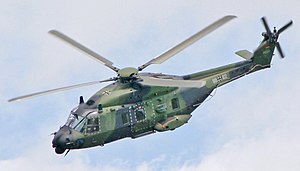NHIndustries NH90
| NH90 | |
|---|---|
 |
|
| An NH90 of the German Army | |
| Role | Medium transport/utility helicopter |
| Manufacturer | NHIndustries |
| First flight | 18 December 1995 |
| Introduction | 2007 |
| Status | In service |
| Primary users |
German Army French Army Italian Army Australian Defence Force |
| Produced | 1995–present |
| Number built | 244 as of July 2015 |
| Unit cost |
€32.5 million (~US$42m) (FY13) TTH
€36.4m (~US$50m) (FY13) NFH support €43.3m (~US$59m) (FY13) NFH attack |
The NHIndustries NH90 is a medium-sized, twin-engine, multi-role military helicopter. It was developed in response to NATO requirements for a battlefield helicopter which would also be capable of being operated in naval environments. The NH90 was developed and is manufactured by NHIndustries, a collaborative company, which is owned by Airbus Helicopters, Leonardo (formerly AgustaWestland) and Fokker Aerostructures. The first prototype conducted its maiden flight in December 1995; the type began to enter operational service with some customers in 2007. As of 2013, a total of thirteen nations have placed orders for the NH90.
The NH90 has the distinction of being the first production helicopter to feature entirely fly by wire flight controls. There are two main variants, the Tactical Transport Helicopter (TTH) for army use and the navalised NATO Frigate Helicopter (NFH); each customer typically has various alterations and customisations made to their own NH90 fleets, such as different weapons, sensors and cabin arrangements, to meet their own specific requirements. In early service, the NH90 has suffered several teething issues, which has in turn delayed active deployment of the type by some operators.
In 1985, France, West Germany, Italy, the Netherlands, and the United Kingdom teamed to develop a NATO battlefield transport and anti-ship/anti-submarine helicopter for the 1990s. The United Kingdom left the team in 1987. On 1 September 1992, NH Industries signed an NH90 design-and-development contract with NAHEMA (NATO Helicopter Management Agency). This agency represented the four participating nations: France, Germany, Italy, and the Netherlands. Portugal later joined the agency in June 2001. Design work on the helicopter started in 1993. The first prototype, PT1, made the type's first flight on 18 December 1995. The second prototype, PT2, first flew on 19 March 1997 and the third prototype, PT3, on 27 November 1998. On 12 December 2002, PT3 became the first helicopter to fly exclusively with fly-by-wire controls following the removal of mechanical back-up controls.
...
Wikipedia
